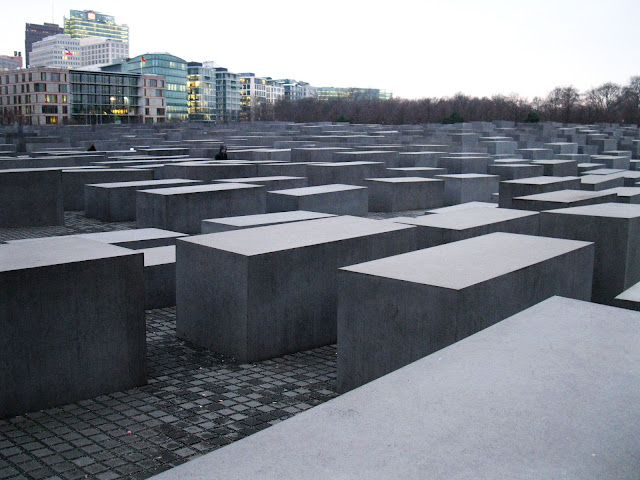As I write this, I'm still basking in the afterglow of a weekend in Berlin. Meghan and I woke up at 4:30am on Thursday morning to leave the Castle and head to Germany. All three of our days and nights were filled up with experiencing the different sides of Berlin.
After checking in to our hostel, which was located in an old brewery building, we walked over to the Jewish Museum. The permanent exhibition is interesting, and we also got to see an art installation and a photography display of different sukkot from around the world. But by far the most interesting thing at the Jewish Museum is the building itself. It was designed by Daniel Libeskind and has three main axes: the Axis of Exile, the Axis of the Holocaust, and the Axis of Continuity (which is the largest part). The building has lots of angles and is meant to show that history takes different paths. There is also a void that runs through the central line of the museum - basically, it's an enclosed empty space intersecting the museum's space. Christoph, a very informative and very chatty employee of the museum, explained that Libeskind wants the building's design to be open to interpretation so each person has a different experience. Christoph also told us that Canada is located in northern Africa. It used to be located in Asia, but it wasn't really comfortable there so it moved in the 1970s. I guess that's that famous German humour...
 |
| The Garden of Exile and the Jewish Museum Berlin |
Meghan and I conquered (read: only got lost once on) Berlin's subway system, the U-Bahn. We were so good at taking the U-Bahn that locals kept asking us for directions. Unfortunately, we had to answer "Sorry, English" each time. One of my favourite things about the U-Bahn: most of the train windows were covered in a pattern of the Brandenburg Gate. The Brandenburg Gate, an old royal entrance to the city, originally stood for victory but then, due to various episodes in Germany's history, was changed to stand for peace. Every time you look out the window, your view of Berlin includes the capital city's complex history.
 |
| View of Berlin through the Brandenburg Gate pattern on a train window |
We did a great walking tour of Berlin that took us to a lot of the main historically significant sites. We saw the National Gallery, the Protestant Cathedral, and the French and German Catholic Cathedrals. We stopped at Checkpoint Charlie and saw the second longest remaining stretch of the Berlin Wall. We saw the memorial to the Nazi book burnings, the Memorial to the Murdered Jews of Europe, and stood over the site of Hitler's underground bunker.
 |
| Berlin Wall, protected by a fence |
 |
| Memorial to the Nazi book burnings at Bebelplatz: a window onto empty book cases below ground level |
 |
| Memorial to the Murdered Jews of Europe, in view of central Berlin |










































